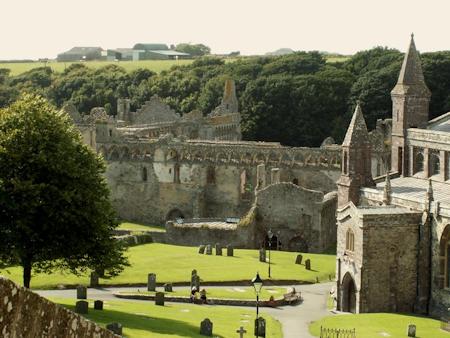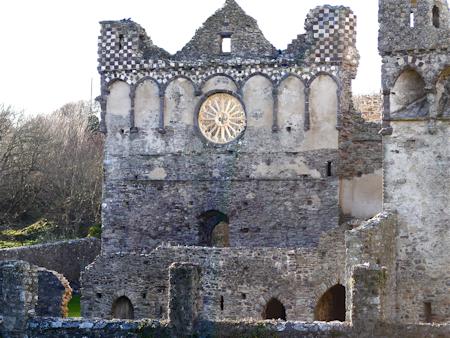
St Davids Bishop's Palace
St Davids Castle and the later Bishop's Palace were built by a series of 'builder bishops'. The Bishop's Palace and St David's Cathedral that were built near the castle during the 13th and 14th centuries comprised one of the most important ecclesiastical sites in Wales.
A monastery was established at St Davids in the 6th Century by Saint David, Abbot of Menevia, later the patron saint of Wales. The monastery was a key religious site and hence a rich target for Viking raiders. It was attacked repeatedly.
In 1081 William the Conqueror paid a pilgrimage to the monastery, recognising its importance as a religious site.
The First Castle
By 1115 the area was under Norman control. King Henry I of England appointed Bishop Bernard to the see of St Davids.
Bishop Bernard began construction of the cathedral on the site of the monastery. He also constructed a small castle about half a mile west of the cathedral to protect the site.
The castle was a ringwork with a semi-circular rampart. There was no banking on the east side where the River Alun would have afforded some protection. You can still see the castle's site today from the road.
In 1123 Pope Calixtus II bestowed a Papal privilege upon St Davids making it a centre of pilgrimage. In 1171 King Henry II visited the Cathedral on his pilgrimage and boosted its popularity to such a degree that a new cathedral was required. It is this second Cathedral that we see today, albeit with considerable modifications.
The Bishop's Palace
By 1200 the earthwork castle had been completely superseded by the Bishop's Palace beside the Cathedral.
In the 1280s Bishop Thomas Beck constructed the chapel in the southwest corner. He also added the hall, private apartments and the gate. In 1284 King Edward I visited the site on his pilgrimage.
The Bishop most responsible for the Palace we see today was Bishop Henry de Gower who served from 1328-47. He undertook a major programme of building works on the site.
St Davids Cathedral was extensively modified including the addition of the rood screen.
In the Bishop's Palace he constructed the two great ranges and an arcaded parapet wall around the palace. He built an additional plain defensive wall around the Cathedral, Palace and canons' houses.
The ranges were his main legacy. The east range contained his private apartments, the kitchens and the Bishop's Hall. The south range was built for entertaining guests and contained the Great Hall and Great Chamber.
The Reformation in the 16th Century saw the decline of the Palace. One of the Bishops removed a significant amount of leading from the roof. In time the Bishops gradually moved to Abergwili and the building fell into disrepair. By 1616 the Palace was thought to be beyond repair.
Modern Day
Today the site is looked after by Cadw who open it to the public as a visitor attraction and open-air theatre.
Between 2003 and 2009 Cadw undertook an extensive restoration programme. The primary goal of the works was to stabilise the fabric of the building which was in danger of collapse in places. They also undertook work to improve the accessibility of the site and the whole project was shortlisted for a prize by the Pan-European Federation of Cultural Heritage.
Even in its ruined state the Palace is still an impressive structure. In the undercroft Cadw has installed various information boards about the history and heritage of the site.
Other facilities available on the site include toilets, baby-changing facilities, disabled access and a gift shop.
Status: Heritage Site / Religious Site / Visitor Attraction
Owner: Cadw
Tel: +44 (0) 1437 720 517
Website: cadw.wales.gov.uk
Opening Times: March to June Daily 9.30am-5pm / July to August Daily 9.30am-6pm / September to October Daily 9.30am-5pm / November to February Mon-Sat 10am-5pm and Sun 11am-4pm


Overlooking the Bishop's Palace with the Cathedral on the right

The Wheel window in the east gable